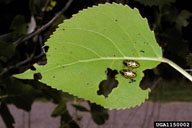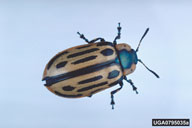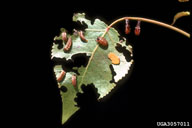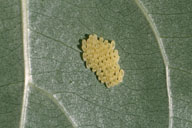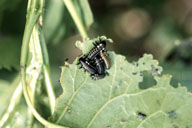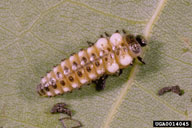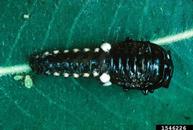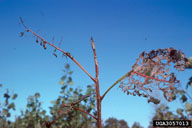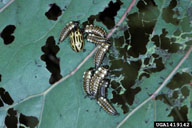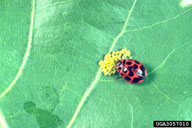Cottonwood leaf beetle
Chrysomela scripta Fabricius (Coleoptera: Chrysomelidae)
Orientation to pest
Cottonwood leaf beetle, Chrysomela scripta Fabricius, is a native insect in North America that feeds on various species of poplar (Populus), willow (Salix), and alder (Alnus) and is found throughout the United States. Adults and larvae feed on leaves, and the yellow eggs are laid in clusters on foliage. Young larvae feed in groups and are leaf skeletonizers. Young larvae emit chemical exudates for defense against predators. Older larvae and adults feed individually. Pupation is on the host plant or nearby materials. Adults overwinter under bark, litter or forest debris, and there are several generations per year (3-4 in the midwestern United States and up to 6-8 in the southern United States). Feeding results in reduced growth and multi-forked tops. Damage is of greatest concern in cottonwood or willow plantations.
Hosts commonly attacked
Various species of poplar (Populus) and occasionally willow (Salix) are attacked by this beetle.
Distribution
Cottonwood leaf beetle is found throughout the United States.
Images of cottonwood leaf beetle
| Figure 1. Adults (top) of the cottonwood leaf beetle, Chrysomela scripta, on leaf and close up of adult beetle (bottom) | Figure 2. An egg mass (yellow) of cottonwood leaf beetle on leaf (top); a close view of an egg mass (bottom) | Figure 3. A group of cottonwood leaf beetle larvae feeding on leaf (top); a close view of a single larva (bottom) |
| Figure 4. Dorsal view of pupa of cottonwood leaf beetle | Figure 5. Damage to eastern cottonwood terminal from cottonwood leaf beetle(left); and close up of damage to leaf from group of feeding larvae (right) | Figure 6. Eggs of cottonwood leaf beetle are preyed on by many generalist predators; here the ladybird beetle Neoharmonia venusta (Melsheimer) | |
Important biological control agents related to this pest species
Natural enemies of this beetle include the microsporidian Nosema scripta Bauer and Pankratz, the ladybird beetle Coleomegilla maculata (De Geer), and the pteromalid parasitoid Shizonotus latus (Wlk.).
Web links for information on cottonwood leaf beetle
- BugwoodWiki Article | wiki.bugwood.org
- Digital Diagnostics Fact Sheet | Oklahoma State University
Compares willow leaf beetle, Chrysomela knabi with cottonwood leaf beetle, Chrysomela scripta
Articles
- Bauer, L. S. and H. S. Pankratz. 1993. Nosema scripta n. sp. (Microsporida: Nosematidae), a microsporidian parasite of the cottonwood leaf beetle, Chrysomela scripta (Coleoptera: Chrysomelidae). Journal of Eukaryotic Microbiology 40(2): 135-141.
- Andersen, D. C. and S. M. Nelson. 2002. Effects of cottonwood leaf beetle, Chrysomela scripta (Coleoptera: Chrysomelidae), on survival and growth of Fremont cottonwood (Populus fremontii) in northwest Colorado. American Midland Naturalist 147: 189-203.
- Tenczar, E. G. and V. A. Krischik. 2006. Management of cottonwood leaf beetle (Coleoptera: Chrysomelidae) with a novel transplant soak and biorational insecticides to conserve coccinellid beetles. Journal of Economic Entomology 99: 102-108.
- Coyle, D. R., E. R. Hart, J. D. McMillin, L. C. Rule, and R. B. Hall. 2008. Effects of repeated cottonwood leaf beetle defoliation on Populus growth and economic value over an 8-year harvest rotation. Forest Ecology and Management 255(8/9): 3365-3373.
